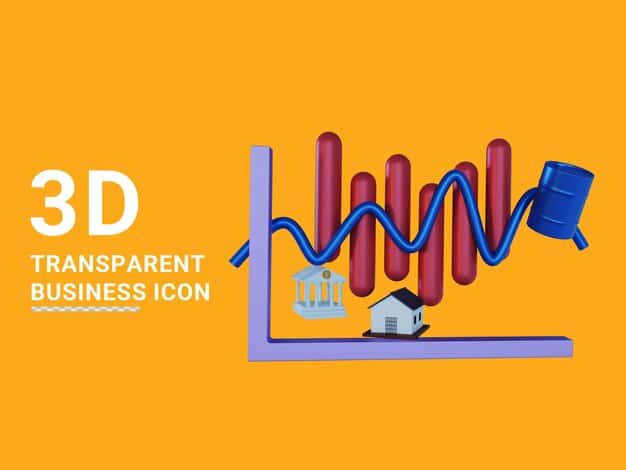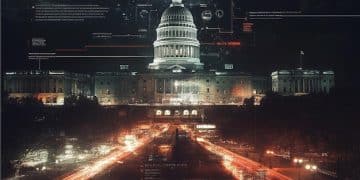US Debt Ceiling Debate: Economic Consequences Unveiled

The US government debt ceiling debate, a recurring political standoff, threatens significant economic disruptions, including potential default, financial market instability, and long-term implications for the nation’s fiscal health and global standing, necessitating a clear understanding of its multifaceted consequences.
The periodic standoff over the US government debt ceiling debate: potential consequences for the economy is more than just a legislative formality; it’s a high-stakes economic drama with profound implications. Each time this political wrestling match unfolds, it casts a shadow of uncertainty over global financial markets and raises serious questions about the stability of the world’s largest economy. Understanding the potential ramifications, from market volatility to long-term fiscal solvency, is crucial for anyone following global economic trends.
Understanding the Debt Ceiling: A Primer
The debt ceiling, formally known as the statutory debt limit, is a legislative cap on the amount of national debt the U.S. government can incur. This seemingly straightforward concept has its roots in the Second Liberty Bond Act of 1917, established to streamline government borrowing during wartime. Originally intended to simplify the process of issuing debt, it has evolved into a potent political tool, frequently leading to intense partisan confrontations.
Each time the government approaches this limit, Congress must vote to raise, suspend, or abolish it. Failure to do so would prevent the Treasury from issuing new debt to meet existing obligations, ranging from Social Security payments and military salaries to tax refunds and interest on existing debt. This unique American institution makes the U.S. one of the few developed nations with such a hard, fixed limit on its borrowing, setting it apart from countries that typically authorize borrowing as part of their budget processes.
Historical Context and Evolution
Historically, raising the debt ceiling was often a routine, bipartisan affair. Presidents and Congresses from both sides of the aisle consistently agreed on hikes as the national debt grew. However, over the past few decades, it has transformed into a contentious battleground. Political parties have increasingly used the debt ceiling as leverage to demand concessions on spending, taxes, or other policy priorities, turning a technical matter into a high-stakes political showdown.
- 1917: Statutory debt limit introduced.
- 1970s onwards: Increased politicization of the debt ceiling.
- 2011: Major crisis nearly triggered a default, leading to a downgrade of the U.S. credit rating by S&P.
- Frequent Debates: Recurring standoffs in recent years reflect ongoing fiscal disagreements.
The evolution of the debt ceiling from administrative tool to political weapon highlights shifting power dynamics within Washington and the growing polarization of American politics. Each debate brings with it a unique set of challenges and demands, further complicating the already intricate dance of fiscal policy and governance.
In essence, the debt ceiling is not about authorizing new spending; it’s about paying for spending already authorized by Congress. When the limit is reached, it signals that the government cannot borrow more money to finance obligations it has already incurred, regardless of whether those obligations are popular or unpopular. This fundamental distinction often gets lost in the political rhetoric, leading to widespread misunderstanding about the true nature of the debate.
The Immediate Threat: Default and Its Ramifications
The most immediate and severe consequence of failing to raise the debt ceiling is a potential U.S. government default. While technical default on some obligations might precede a full-blown crisis, the inability to make timely payments on Treasury securities would be unprecedented and catastrophic. This scenario would send shockwaves through global financial markets, given the central role of U.S. Treasury bonds as the foundation of the international financial system.
A U.S. default would instantly shatter confidence in the reliability of the American government and its financial instruments. Treasury bonds, long considered the safest assets in the world, would be re-evaluated, leading to a sharp increase in borrowing costs not just for the U.S. government, but for corporations, states, and individual consumers. Interest rates on everything from mortgages to car loans could skyrocket, severely impacting economic activity.
Market Instability and Investor Confidence
Beyond soaring interest rates, a default would likely trigger widespread market panic. Stock markets would plunge as investors seek safety, and volatility would become the new norm. The “flight to quality,” which traditionally meant buying U.S. Treasuries during crises, would reverse, creating unprecedented uncertainty. International investors, who hold a significant portion of U.S. debt, might lose trust and shift their investments elsewhere, further weakening the dollar and making future borrowing more expensive.
- Equity Markets: Sharp declines as fear grips investors.
- Bond Markets: Yields surge, prices fall, liquidity concerns arise.
- Currency Markets: U.S. dollar devalues, impacting global trade.
- Commodity Markets: Volatility as global economic outlook darkens.
The very fabric of the global financial architecture relies on the perceived safety and liquidity of U.S. Treasuries. A default would undermine this fundamental pillar, potentially triggering a credit crunch akin to, or even worse than, the 2008 financial crisis. Banks holding vast amounts of U.S. government debt as collateral would face massive losses, threatening their solvency and leading to a freezing of credit markets.
Furthermore, the long-term impact on the U.S. credit rating would be significant. While Standard & Poor’s famously downgraded the U.S. in 2011 even without a default, a full default would guarantee further downgrades from all major rating agencies. This would permanently raise the cost of future U.S. borrowing, diverting taxpayer money from essential services to higher interest payments. The reverberations would be felt for decades, diminishing America’s economic standing and influence on the world stage.
Economic Slowdown and Recessionary Pressures
Even if a full-blown default is narrowly averted, the mere proximity to the debt ceiling can inflict substantial economic damage. Protracted negotiations and the looming threat of default create immense uncertainty, chilling business investment and consumer spending. Companies postpone expansion plans, hiring slows, and households become more cautious with their finances, all contributing to a deceleration of economic activity.
The psychological impact of such a crisis cannot be understated. Businesses thrive on predictability, and the debt ceiling debate introduces an artificial, unnecessary layer of risk. This anxiety permeates every sector, from small businesses struggling to access credit to large corporations wary of making long-term commitments. The cumulative effect of this widespread hesitancy can push an already fragile economy into recession.
Impact on Government Operations and Public Services
Beyond market and business impacts, a debt ceiling breach would directly affect government operations and the provision of public services. The Treasury would be forced to prioritize payments, a move with no statutory or legal guidance. This “prioritization” would inevitably lead to delayed or missed payments for millions of Americans who rely on federal funds.
- Social Security and Medicare: Payments could be disrupted, impacting retirees and vulnerable populations.
- Federal Employee Salaries: Timely payments for military personnel and civil servants could be at risk.
- Tax Refunds: Processing and issuance of refunds might be delayed.
- Government Contracts: Payments to vendors and contractors could be halted, affecting numerous businesses.
Such disruptions would have immediate and severe consequences for affected individuals and families, creating widespread hardship. The cascading effect would then hit local economies as federal payments, which represent a significant portion of many communities’ income, dry up. Businesses reliant on government contracts or federal employee spending would suffer, leading to job losses and further economic contraction.

The uncertainty surrounding government payments would also erode public trust in institutions, which can have long-term societal implications. The government’s ability to deliver essential services and meet its obligations is fundamental to its legitimacy. Any failure in this regard, even if temporary, could damage the social contract and lead to widespread dissatisfaction. This internal disruption, combined with external market shocks, would create a perfect storm for an economic downturn, disproportionately affecting those who can least afford it.
Long-Term Economic and Geopolitical Consequences
Even if the immediate crisis is averted, the recurring nature of the debt ceiling debate leaves an indelible mark on the U.S. economy and its standing in the world. Each episode of brinkmanship erodes investor confidence, not just domestically, but globally. The perception that the U.S. government cannot reliably manage its fiscal affairs begins to take root, prompting a reassessment of its financial stability and leadership.
The U.S. dollar’s role as the world’s primary reserve currency, a status that confers significant economic benefits, could be gradually undermined. If other nations and central banks perceive U.S. Treasury bonds as less secure or more volatile due to political gridlock, they may start diversifying their reserves away from the dollar. This gradual erosion would reduce America’s geopolitical leverage, increase its borrowing costs over time, and diminish its influence in global financial markets.
Impact on Fiscal Policy and Future Borrowing Costs
The repeated flirtations with default also make future borrowing more expensive. Rating agencies, even if they don’t issue immediate downgrades, take note of the increased risk. This risk premium translates into higher interest rates on newly issued U.S. debt. Over decades, even a fractional increase in borrowing costs can amount to trillions of dollars in additional interest payments, diverting funds that could otherwise be invested in infrastructure, education, research, or other growth-enhancing initiatives.
The politicization of the debt ceiling also complicates the ability of Congress to conduct sound fiscal policy. Instead of debating the merits of spending and taxation in a structured budget process, critical fiscal decisions are held hostage to an artificial deadline. This creates a reactive, crisis-driven approach to governance, making it harder to address long-term fiscal challenges such as entitlement reform or rising healthcare costs. The focus shifts from responsible governance to political survival.
- Higher Interest Payments: Increased debt servicing costs on national debt.
- Reduced Fiscal Flexibility: Less room for strategic investments or crisis response.
- Diminished Global Role: Decline in the dollar’s status and U.S. financial leadership.
- Political Dysfunction: Further entrenchment of partisan gridlock.
Internationally, the debt ceiling debate chips away at America’s credibility as a reliable economic partner. Allies and adversaries alike watch these standoffs with concern, wondering whether the U.S. can sustain its economic commitments. This uncertainty can destabilize international relations and prompt other countries to seek alternative global leadership, both economically and politically. The long-term reputational damage is difficult to quantify but potentially profound, affecting everything from trade agreements to diplomatic alliances.
Contingency Measures and Political Strategies
In response to the recurring debt ceiling crises, various contingency measures and political strategies have been proposed or informally discussed. These range from innovative legal theories to more drastic legislative maneuvers, all aimed at circumnavigating the political gridlock that often surrounds raising the borrowing limit. However, each potential solution comes with its own set of risks and Constitutional questions.
One notable strategy that garners attention is the “trillion-dollar coin” argument, suggesting the Treasury could mint a platinum coin of an arbitrarily high denomination (e.g., $1 trillion) and deposit it at the Federal Reserve to create sufficient funds to pay government bills. While technically possible under specific legal interpretations, this idea is largely dismissed as a gimmick that could severely undermine confidence in the U.S. currency and the rule of law, potentially leading to hyperinflationary fears.
Alternative Legislative Approaches
More conventional legislative approaches include abolishing the debt ceiling entirely or linking it directly to the budget process. Some argue that the debt ceiling is redundant, given that Congress already approves spending through appropriations bills. Abolishing it would remove the arbitrary crisis point, forcing Congress to take responsibility for its spending decisions upfront rather than later. Another proposal involves automatically raising the debt ceiling in line with budget resolutions, ensuring that authorized spending is always matched by borrowing authority.
- Abolition: Eliminate the statutory debt limit altogether.
- Automatic Adjustments: Link the ceiling to budget appropriations or GDP growth.
- 14th Amendment Invocation: Presidential assertion that the debt ceiling is unconstitutional.
- Legal Challenges: Court cases to determine constitutionality of the debt ceiling.
The debate around the 14th Amendment, specifically Section 4 which states the “validity of the public debt of the United States…shall not be questioned,” offers another potential, albeit controversial, pathway. Some legal scholars argue this clause grants the President the power to disregard the debt ceiling if it prevents the government from honoring lawfully incurred debts. However, employing such an interpretation could lead to a severe constitutional crisis, raising questions about the balance of powers and potentially inviting impeachment proceedings. It’s a legal tightrope walk with unpredictable political repercussions.

Ultimately, these strategies highlight the difficult position policymakers find themselves in. While some may offer temporary relief or theoretical paths forward, they often involve navigating uncharted legal and political territory. The ideal solution remains a bipartisan commitment to responsible fiscal management and a political agreement to treat the debt ceiling as a technical necessity rather than a bargaining chip. Without such a shift, the U.S. economy will likely remain vulnerable to these self-inflicted wounds.
The Path Forward: Solutions and Recommendations
Addressing the recurring debt ceiling debates requires moving beyond short-term fixes and towards systemic solutions that foster fiscal responsibility and political stability. While the immediate focus during a crisis is often on averting default, a long-term perspective demands structural reforms to how the U.S. manages its debt and budgetary processes. The ultimate goal should be to depoliticize the debt ceiling, transforming it from a weapon into a routine administrative function.
One primary recommendation involves adopting a rules-based fiscal framework, similar to those found in many other developed economies. Such frameworks often include mechanisms for managing deficits and debt, alongside clear procedures for approving government spending. This would create a more predictable fiscal environment and reduce the likelihood of last-minute legislative scrambles that risk economic stability.
Bipartisan Cooperation and Long-Term Fiscal Planning
Crucially, true progress hinges on a renewed spirit of bipartisan cooperation. The debt ceiling continually serves as a stark reminder that both parties must eventually find common ground on fiscal matters. This involves acknowledging the long-term challenges of rising national debt, such as the sustainability of entitlement programs, and working collaboratively on solutions that transcend electoral cycles. A focus on data-driven policy decisions, rather than politically motivated grandstanding, is essential.
- Establish Independent Fiscal Commission: A non-partisan body to propose debt reduction strategies.
- Implement Budget Process Reforms: Streamline appropriations to avoid spending overlaps and disputes.
- Promote Public Education: Improve understanding of the debt ceiling and government finances.
- Convene Cross-Party Dialogues: Facilitate regular discussions on fiscal sustainability.
Another pragmatic approach involves separating the vote on the debt ceiling from broader fiscal debates. Some proposals suggest that the debt ceiling should be raised automatically whenever Congress passes spending bills, effectively linking borrowing authority directly to appropriations. This would ensure that once spending is approved, the means to pay for it are also automatically provided, preventing hostage-taking scenarios. Such a reform would eliminate the incentive to use the debt ceiling as leverage for unrelated policy demands.
Moreover, fostering greater transparency in government finances and enhancing public understanding of the national debt is vital. When citizens are better informed about the implications of fiscal choices, it can create a more constructive environment for political dialogue and pressure elected officials to find sustainable solutions. This includes clearly distinguishing between new spending authorizations and the need to pay for existing obligations, a distinction often blurred during debt ceiling debates. Only through a combination of institutional reform, political goodwill, and public awareness can the U.S. effectively navigate its fiscal future and mitigate the risks posed by the debt ceiling.
| Key Point | Brief Description |
|---|---|
| 📊 Debt Ceiling Basics | A legislative cap on US government borrowing, evolved into a political tool. |
| 🚨 Default Risk | Failure to raise the ceiling could lead to a catastrophic U.S. default, impacting global markets. |
| 📉 Economic Downturn | Uncertainty from debates can slow investment, spending, and disrupt public services. |
| 🌐 Global Standing | Repeated crises threaten the U.S. dollar’s reserve currency status and geopolitical influence. |
Frequently Asked Questions about the US Debt Ceiling
The US debt ceiling is a statutory limit on the total amount of money the United States government can borrow. This limit applies to nearly all federal debt, including money owed to the public (like Treasury bonds) and money owed to government accounts (like Social Security and Medicare trust funds). It is not a limit on future spending, but rather on the government’s ability to pay for existing legal obligations.
If the debt ceiling is not raised, the US Treasury would face a severe cash crunch, unable to issue new debt to cover its financial obligations. This could lead to a default on government payments, including Social Security benefits, military salaries, and interest on bonds. Such a default would trigger financial market chaos, a likely global recession, and a significant downgrade of the US credit rating.
Debt ceiling debates create immense economic uncertainty. Businesses may delay investments, consumer confidence can wane, and financial markets become volatile. Even if a default is avoided, the brinkmanship can lead to higher borrowing costs for the government, dampen economic growth, and potentially increase unemployment. It undermines predictability, which is crucial for a stable economic environment and damages long-term investor confidence.
The debt ceiling has evolved from a technical necessity into a potent political leverage point. Opposing parties often use the deadline to demand concessions on spending cuts or other policy priorities from the sitting administration. This turns a routine administrative act into a high-stakes negotiation, fueled by partisan divisions and differing views on fiscal policy, making compromise exceptionally difficult and risking economic stability.
Several solutions have been proposed, including outright abolition of the debt ceiling, linking it automatically to Congressional spending bills, or empowering the Treasury to manage debt without a hard limit. Other suggestions involve invoking the 14th Amendment or creating an independent fiscal commission. However, each proposal faces political and legal hurdles. The most effective long-term solution lies in bipartisan cooperation on fiscal policy and a depoliticization of the issue.
Conclusion
The recurring spectacle of the US government debt ceiling debate is more than a mere political skirmish; it represents a significant, self-imposed risk to the American and global economies. From the immediate threat of a catastrophic default and ensuing market instability to the slow erosion of long-term economic confidence and geopolitical standing, the consequences of this fiscal brinkmanship are profound. While the short-term focus remains on averting the next crisis, the long-term health of the U.S. economy and its standing in the world demand a more sustainable, less volatile approach to managing national debt. Moving forward, a combination of legislative reform, a renewed commitment to bipartisan dialogue, and a clearer understanding of the stakes involved will be crucial to mitigate these recurring threats and ensure continued economic stability.





